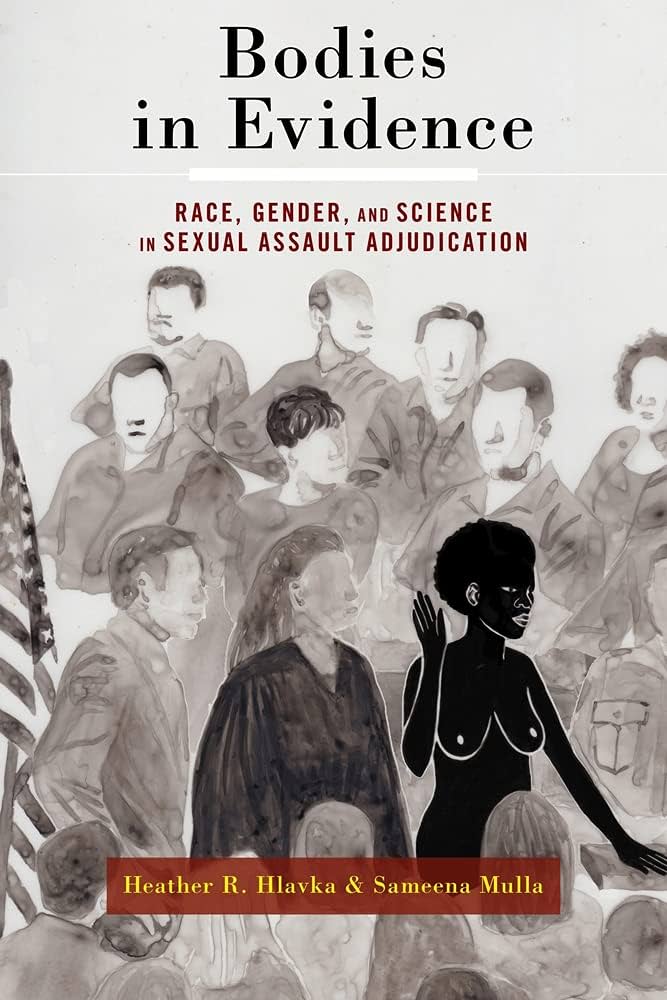Reviewed Book
Bodies in Evidence: Race, Gender, and Science in Sexual Assault Adjudication By Heather R. Hlavka and Sameena Mulla. New York: NYU Press, 2021. pp. 312.

Alessandra Gribaldo
Set in Milwaukee’s felony courts, Bodies in Evidence draws the reader into the immersive world of the adjudication of sexual violence by directly taking on the contradictions, complexities, and occlusions that characterize these cases in the US context. Heather R. Hlavka and Sameena Mulla draw on multiple methods, including analysis of archival documents, sentencing transcripts, semi-structured interviews with legal professionals and the diverse actors involved in the justice system, and, concurrently, three years of team fieldwork with hundreds of court hearings observations. The result is a refined and profound analysis that illuminates the emotional and affective labor of all courtroom participants.
Although we know that the force of law is disproportionately used against Black and Brown people across United States, the opening story of a young Black woman who is a victim of violence, and the way her case is treated in court, is striking. Hlavka and Mulla do not simply denounce racism and sexism in the courts. Instead, through their insightful ethnography, they detail the extent to which the victim, evidence, hearings, and truth itself are embedded within a frame that ensures their imperviousness to genuine justice. As we move further into the book, legal process, factual knowledge, and the administration of justice become the frame within which structural and intersectional violence clearly emerge.
The first issue that Hlavka and Mulla address is the process of jury selection by judges and attorneys. This process is extremely interesting in the Milwaukee context, in which the population is 40 percent African American, defendants are overwhelmingly Black and Latino, and court staff (judges, prosecutors, defense attorneys, and clerks) are mostly white. The work of selecting and sensitizing jurors reveals exceptionally ambivalent dynamics of valuing and “containing” the jurors’ experience. Selection follows the intertwining of shared experience, common knowledge, and the pedagogical desire of the court to prevent jurors from relying on their stated biases. Racism, though rarely addressed explicitly in court, is traceable in every hearing as Black women are often hypersexualized, young Black girls adultified, and Black men represented as sexually aberrant and absent fathers.
The voices of the victims, whose testimonies are trapped within the confines of legal storytelling protocols and whose suffering is amplified by the dynamics of the trial, reveal how the duplicity of trauma is handled by the court. Sexual assault becomes the event that cannot be recounted without undermining the credibility of the witness, whose capacity for judgement is reputed to be challenged by the experience itself. At the same time, the testimonies of police officers, mostly male and white or white passing, are likely to be believed, despite their long history of abuse.
One of the most nuanced aspects of Bodies in Evidence is the focus on the statements, postures, and testimonies of sexual assault nurse examiners and forensic scientists. Both of these jobs are commonly held by women, and sexual assault nurse examiners are rarely called in to testify, as they are considered potentially too pro-victim and because forensic examination does not lead to evidence of assault-related injuries or DNA findings. Their testimonies in court intertwine medicine, science, law, and culturally informed models of knowledge through visualization. The performances of forensic scientists, who in the authors’ fieldwork were mostly women and always white, are observed with ethnographic sensibility for the ways they reproduce jargon and tone through linguistic strategies that make their testimony objective and inevitably lead to processes of essentializing biological race. Several recurring motifs emerge in the book questioning the idea that forensic evidence is conclusive, scientific, and final, and that DNA, blood, and fingerprints are facts. Hlavka and Mulla note that a whole epistemology of legal evidence and truth is deployed, where forensic evidence stands for rationality and testimony for emotionality.
The last chapter is focused on defendants. Based on two cases examined in depth, one with a Black male defendant and the other with a white male defendant, the authors explore how the court reproduces notions of appropriate performances of masculinity, following racial and class stereotypes and referring to the supposed intergenerational transmission of pathology within the Black community. The text closes with a series of reflections on how certain ethnographic observations resist interpretation, insisting on the human costs of the sexual assault trial and on the law as a site of racial and gendered struggle.
While Hlavka and Mulla’s decision to analyze cases of violence against women and against children within a single framework runs the risk of obscuring case-specific differences (particularly those involving incest), it also allows some decisive issues to emerge that shape the space of legal management of sexual violence: credibility, evidence, intersectional structural violence, institutionalized ways of seeing and speaking, and heteronormative archetypes. Finally, Hlavka and Mulla highlight the paradox of dealing with issues of justice that cannot be handled properly in court as they do not fit legal expectations and thus the criminal system does not offer redress. If, as it is clear, unlikely victims find a way to process trauma or find justice in court, this book brings a feminist perspective to criminalization that opens up political possibilities to imagine and reclaim a more just society.
References
Hlavka, Heather R., and Sameena Mulla. 2021. Bodies in Evidence. Race, Gender, and Science in Sexual Assault Adjudication. New York: NYU Press, 2021.